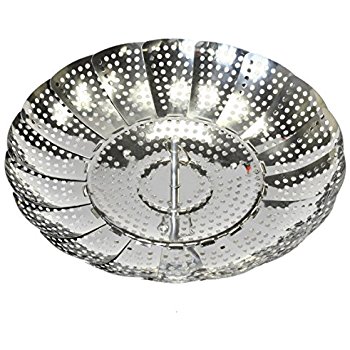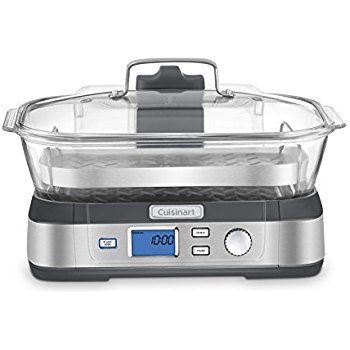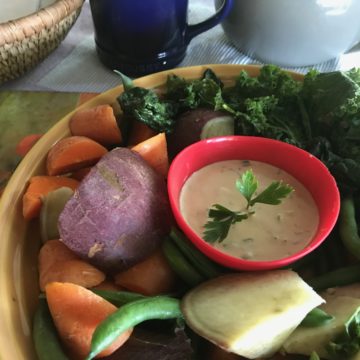I was never particularly a fan of steamed vegetables, until I went on a special diet to improve my health a year and a half ago – which was basically eating mostly steamed organic veggies along with certain types of protein. I stuck to this diet pretty religiously as I was facing some surgeries and wanted to be in tip-top shape. Well, it worked! Within a month, I felt much stronger, had more energy and as a side effect I had lost 10 pounds! I did not set out to lose that weight, but it was a welcome bonus.

Ready to go!
To this day, I continue to gladly eat steamed vegetables, almost on a daily basis. I often have them for breakfast with a poached egg over the greens or as a simple omelet alongside the veggies. It’s a great way to start my day, and no, I truly don’t mind eating veggies for breakfast. I feel great after eating them, and I have come to love their pure and simple tastes at any time of the day. I tend now to have them either for breakfast and/or lunch, and then eat a “normal” dinner with my family. “Normal” means we don’t eat a lot of steamed vegetables with dinner, but actually sometimes we do, like fresh green beans, broccolini, cauliflower, potatoes, asparagus…

Breakfast!
Early on in my steamed veggie routine, I developed my own adaptation of a tahini-miso sauce. I don’t remember where I first saw the idea, so I can’t give specific credit. However, I am including my version of it in the attached recipes. I love this sauce, and it is so easy to put together while the vegetables are steaming. Of course, there are many sauces one could make to accompany steamed vegetables. Sometimes I just use leftover sauces from other dishes I’ve made, like the yogurt sorrel sauce (pictured below) or a parsley oil (by Yotam Ottolenghi) that is so delicious.

Steamed veggies with sorrel sauce
I cannot overstate how wonderful it is to have an organic garden to pick fresh veggies from, and to have a variety for steaming that meets most of my daily needs. While my staples have become carrots, kale and green beans, I love adding in other ingredients on an as-available basis: kohlrabi, broccoli, turnip, beets, and so on. See our posts Spring Harvest (1) and Spring Harvest (2) for an idea of the variety of veggies we grow. I do supplement from the market when needed, especially in our off-season (summer).
A note about steamers: I have a very nice, high quality steamer set I bought years ago from Demeyere Sirocco which is unfortunately no longer made. There is a company named Atlantis which makes a similar set (the top half is pictured below), which I’ve no experience with. I love using a steamer pot which is basically one solid pot on the bottom and another that sits above it with holes in the bottom. Also, a search on Amazon yields many different stainless steamer pots as well.

Top half of Atlantis steamer
When I travel, I often stay in rentals with kitchens, and so I take along a simple stainless steamer that opens up to fit most medium to large pots. It is very inexpensive and can actually be used on a daily basis, as I did many years ago.
Steamer basketA few of my friends have bought a Cuisinart digital electric steamer, which I have tried and it works well. Since I already have my Demeyere and enjoy the timing I have down for different veggies, as well as cooking on my gas stove, I am sticking to that. But the electric is very efficient and convenient, I must say. It does take up counter space!

Cuisinart electric steamer
Steamed vegetables may seem like a boring way to eat, but I would never want to do without them now! I feel great after eating, with good energy and unnoticeable digestion. With a little added protein, I am good to go for many of my meals! And I am happy to know that most of the nutrients in my veggies are maintained when steaming is the cooking method. It’s interesting how a return to simplicity can become so enjoyable, and beneficial as well.
So I want to show the sequence I follow with steaming vegetables here. I like to cut up the harder veggies, such as carrots, beets, kohlrabi and sweet potatoes, into uneven chunks. I do this because they seem to be more manageable in the steamer together, rather than having all circular, flat chunks. So after boiling my water in the lower pot, I place the steamer basket on top with my harder-core vegetables.

Steaming – first step, harder vegetables
The second step is placing my medium density or texture veggies in – such as green beans, broccoli stems, cauliflower, apples (yes, a fruit), etc. When I do this is a matter of learning through practice – I generally give the hardest veggies (carrots, etc.) about a five minute head start on the medium hardness ones.

Next layer – medium hardness veggies
And lastly, I put in my greens and any very soft veggies such as snow peas or even broccoli if I want it firm. I have read recent research that the optimal time to steam kale is four minutes in order to retain its nutrient value; I generally go about five minutes as I tend to steam at a fairly low boil and like a nice wilted consistency.

kale goes last – on top of other veggies
When they are all done, I turn them out onto a plate. I do not butter and salt them (as I do when steaming vegetables for my family). I love them plain, or with my miso-tahini dressing – see attached recipe!
Bon appetit!

Miso-tahini with lemon is my go-to sauce to accompany my steamed vegetables. I like to make enough to last a few days, as it keeps that long and I love always having it available. It adds a nice nutritional and protein boost to the veggies, along with other protein I might eat for the meal.
I discovered a really wonderful tahini last year called "Soom" (available on Amazon). It is just supreme - so smooth and delicious, and of course more expensive than other brands. What I do for this sauce is mix the Soom half-and-half with another kind of tahini. Right now I am favoring a brand called "Once Again." The combo works well for this sauce.
When it comes to the miso, I have always found the Cold Mountain brand to be excellent. I use their Mellow White miso (I tried yellow once, no, not good for this sauce!). The miso keeps for a very, very long time.
This is a very simple sauce to make - it can be easily done while veggies are steaming so everything's ready at once. I like adding fresh herbs from the garden - usually parsley, sometimes garlic chives (or both) - whatever your heart desires.
- 2 Tb tahini (sesame seed paste)
- 2 Tb water
- 2 1/2 tsp white miso
- 2 Tb lemon juice freshly squeezed
- few sprigs parsley Optional
- 1 tsp sesame seeds, toasted Optional
-
Make sure your tahini is stirred to a well-mixed constitution in the jar before using. Place 2 Tb of the tahini in a bowl with the water and stir well with a fork until very smooth.

-
Add the miso paste and lemon juice to the tahini mix and stir well to combine. Taste for each ingredient and add as needed; if too thick add more water or lemon juice.

-
Chop the parsley into small bits and add to the miso-tahini mix along with the toasted sesame seeds. Or add any herb/seed/nut mixture you like to the sauce, to your liking.

-
Stir well to combine. Serve with steamed vegetables.





